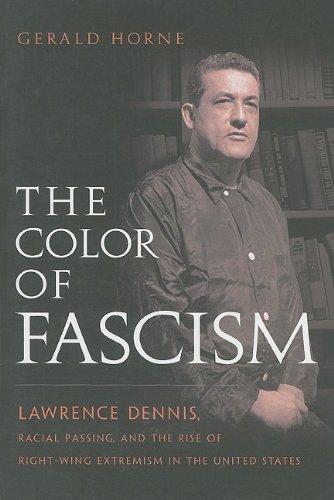“Black No More”?: Walter White, Hydroquinone, and the “Negro Problem”
American Studies
Volume 47, Number 1 (Spring 2006)
pages 5-30
Eric Porter, Professor of American Studies
University of California, Santa Cruz
In an August 1949 Look magazine article—”Has Science Conquered the Color Line?”—NAACP Executive Secretary Walter White pondered the social implications of monobenzyl ether of hydroquinone, an antioxidant used in rubber and plastics manufacturing that had recently been found to remove melanin from human skin. Government investigators had publicly identified this effect in 1940, after investigating complaints by black and Mexican workers at a Texas tannery who developed pale patches of skin on their hands, arms and torsos because of the presence of hydroquinone in their protective gloves. Hydroquinone would eventually be used medicinally to treat severe forms of vitiligo (a disease involving the progressive loss of melanin which makes one’s skin appear mottled) by removing the remaining melanin from patients’ skin, thus evening out their skin tone. It has also been used as a fading compound to treat different kinds of localized hyper-pigmentations and is still found in often-dangerous skin lightening cosmetic products sold to people with dark complexions across the globe.
In 1949, however, the ultimate medical, cosmetic, and social impacts of hydroquinone were still unknown. White wrote his article after traveling to Chicago to meet with scientists engaged in research on the substance. Afterwards, he took it upon himself to speculate on its future in ways that echoed George Schuyler’s 1931 prototypical black science fiction novel Black No More, in which Dr. Junius Crookman, a fictional Harlem physician, devises a way to induce vitiligo “at will” and “solve the American race problem” by turning dark skins pale. Unfortunately for White, his speculations, which might be described as a bad piece of journalism that degenerated into an involuntary piece of science fiction, rendered him a lightning rod for criticism. For the civil rights leader seemed to suggest that hydroquinone provided a solution to the problems of segregation, racism, and colonialism in the post-World War II world by enabling non-white peoples to bleach their skins.
White’s article baffled his contemporaries. Not only did he seem to be advocating an absurd, demeaning, and physically damaging political strategy; some were also struck by the irony that the comments about hydroquinone came from the blond-haired, blue-eyed Executive Secretary of the NAACP. Early in his tenure with the organization, White had been sent to the South to gather information for the organization’s anti-lynching crusade and did so, risking his life in the process, by passing as a white traveling salesman. His career as a “race man” and his leadership of the NAACP since 1931 both affirmed as well as called into question definitions of racial identity, which in turn prompted questions about his role at the organization’s helm…
…What I will argue, however, is that, whatever White’s professional motivations, the ideas embedded in “Has Science Conquered the Color Line?” and especially in a somewhat longer, unpublished version of the piece, the resonances of these ideas with other bits of White’s public commentary, and responses to the Look article by black leaders and lay people alike—all give insight into some of the political and moral dilemmas revolving around race, science, and civil and human rights during the immediate postwar period. Moreover, they illustrate how a scientific, political, and moral imperative to abandon racial thinking had entered African American political and popular discourse by the end of the 1940s. This imperative emanated from decades of research seeking to debunk race as a biological category, and it was given new immediacy by both the horrors of Nazi racial science put into practice and a post-Hiroshima and Nagasaki faith in science, technology, and rational thought as vehicles by which to overcome the problems of the world (the racist and genocidal applications of the bombing notwithstanding). The notion that race was irrational and irrelevant was increasingly prominent, albeit in complicated ways, through the 1940s within a broader, transnational context of academic writing, journalistic reportage, and the rhetoric of statecraft. But it had a particular and no less complicated resonance among African Americans during the immediate post-World War II era.
White’s article and the controversies it elicited demonstrate how dilemmas around race and rights, conditioned by scientific research on race, were, in fact, significant components of black racial formations at mid-century. The imperative to move beyond race affected other political and personal choices—for example, national versus international affiliation, the primacy of race or class in social analysis, integrationist versus nationalist civil rights agendas, race consciousness versus color blindness in personal deportment and interpersonal relations—facing African Americans. And it caused people to ponder the usefulness of the sense of black virtue that constituted their own understanding of what it meant to be human.
This essay moves next to an assessment of “Has Science Conquered the Color Line?” and issues that arose as White, a middle-class “race man” capable of passing as white, tried to debunk the idea that race had a biological basis while maintaining a link to his racial community. The investigation continues by examining the controversy surrounding White’s piece, which demonstrates how political leaders and lay people alike addressed the limitations and value in racial affiliation and racial transcendence. In the process, it explores some of the conceptual and political questions about race, science, and rights that emerged as black leaders like White contemplated the Faustian bargain of linking domestic civil rights struggles to U.S. foreign policy goals and a concomitant ethos of color blindness. The conclusion revisits the idea that engagements with scientific accounts of race were significant to African American racial formations at mid-century, and it ponders the implications of these engagements in light of scholarly claims about the importance of black political cultures and racial discourses during this period…
Read the entire article here.

